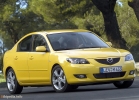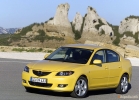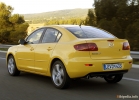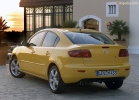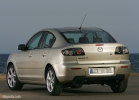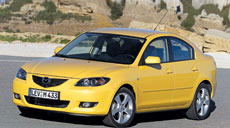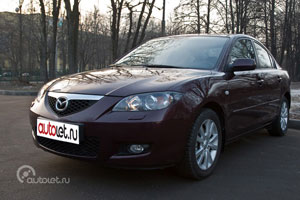Test drive Mazda Mazda 3 (Axela) Sedan 2004 - 2009 sedan
Mazda-Romeo, or Japanese Zoom-Zoom
Once, during the ALFA Romeo 147 test, I recklessly said: a cool car, but if it was collected in Japan, she would not be prices! The dealer was offended, probably thinking something like: what are you, bespectacled, you understand in great and pure love! But the thought of such a combination as a Japanese car with an Italian design and temperament seemed quite interesting to me. And now, sitting behind the wheel of a new Mazda3, I thought that dreams are still coming true, because you have a real Italian car, only created in Japan!Change of direction
Let these words, carried out in the title, will not become the reason for the resentment of the Mazda dealer. Agree that all the previous generations of Japanese cars were very good, incredibly reliable and trouble -free, but I think no one will become about the style. Not that the Japanese had any problems with designers. No, if desired, they could well create beautiful and stylish cars, such as the Mazda RX7 or Lexus GS300. But the problem is that the appearance of mass models of Mazda was made as universal as possible, so that the car is attractive as many potential buyers as possible.
Now other times, and having achieved the phenomenal reliability of their machines, the Japanese realized the need to create impulsive and image models that combine functionality, practicality and high style. And even the new concept was invented - Zoom -Zoom is called (they heard, probably?).
The first swallow was Mazda6 - a follower of the legendary 626th. It was followed by a compact deuce created on the same platform with the new Ford Fiesta, and the RX8 sports model, which has a rather unusual body type - a four -door compartment. And the last model created in the framework of the Zoom-Zoom concept has become the new Mazda3, a representative of the most densely populated sector of the market.
At the end of November, the novelty already appeared in Belarus, and the dealer held a presentation of a new family of small middle -class models, today presented in the form of a sedan and hatchback.
The best decision
The design of Mazda3 will be interesting to everyone who is somehow interested in cars, because in the new Mazda almost all the achievements of the modern automotive industry are embodied.
The novelty was created on a completely new everything all -off platform and has completely independent pendants of all the wheels - in front of McPherson, and in the back - a multi -link scheme. This is almost like the oldest Mazda6 - the most successful and driver of Mazda model in recent years. With the six, by the way, the Mazda3 is very similar in the chassis settings.
The wheelbase has been increased, which provided additional cm spaces in the cabin, especially in the area of \u200b\u200bthe rear seats. In comparison with the predecessor, the new triple was also significantly heard in height and width and, in some parameters, came close to the middle class cars. The width of the salon is at the level of the shoulders, the distance between the front and the rear seats, the height of the ceiling - according to these parameters, the Mazda3 is knocked into the leaders of its class.
The troika body created using the Maidas technology (the distribution and absorption system of the impact energy) has a strong built -in frame that protects passengers in collisions. In the Mazda3 database, there are four airbags - the front front and front side, and the versions are rickely equipped with eight eirbegs! The list of active security systems also includes ABS with the electronic distribution system of brake force, and more expensive modifications are equipped with the TCS anti -wings system and the DSC stabilization and traction control system.
The range of power units so far consists of only two gasoline engines: 1.6- and 2.0-liter. Both engines belonging to the new MRZ series have four valves per cylinder, fuel injection with electronic controls and a timing chain drive. The latter, by the way, allows you to reduce operating costs, because the chain, unlike the timing belt, does not require replacement throughout the entire life of the car!
The smaller 105-horsepower engine is equipped with a system for changing gas distribution phases SV-T, which makes it more elastic and traction. Now the motor does not have pronounced peaks and power failures, since thanks to the SV-T system, torque is evenly distributed throughout the speed range. That is, you can use the potential of the engine constantly without twisting it to the red zone of the tachometer. In practice, this leads to the fact that it is possible to switch transmissions less often - the motor confidently pulls from low speeds, has high thrust on medium and pleasant seizure at high speeds. That is, the peak power remains almost the same, but thanks to the system of changes in the gas distribution phases, the motor becomes more convenient to operate: the car is faster and easier to accelerates from any engine speed, for overtaking you do not have to switch to a lower gear, etc. But at the same time, the most interesting does not suffer at all: the average Mazda3 consumption with a 1.6-liter engine is about 7.2 liters.
The two-liter engine is not equipped with a SV-T system, but it is not necessary for him, by and large, with such a power! 150 hp were removed from two liters of working volume, which is a very good indicator in this class - competitors are content with an average of 125-140 hp. Of the haltering in this motor, there is a plastic intake manifolder of a variable length - it is easier than usual and, moreover, easier in the repair. In addition, the changeable length of the collector partially performs the functions of the SV-T system: the process of supplying oxygen into the combustion chamber is optimized, the cylinder is improved, etc. However, even without various improvement systems, a 2.0 liter engine copes with its duties. The dynamics of acceleration, maximum speed, burden - in all these parameters, Mazda3 2.0 came close to the best GTI modifications of the small middle class. Acceleration from a place to 100 km/h - in just 8.8 seconds!
All Drive!
For the test we were provided at once by two versions of Mazda3-a sedan with a 1.6-liter engine and hatchback, a 150-horsepower top version with a two-liter engine. Naturally, we were more interested in the second car - the hatchback and outwardly more interesting, and its equipment is much better than that of the sedan. We will talk about a four-door car with a 1.6-liter engine later, but for now all attention to him-2.0-liter hatchback!
We will not talk about the exterior for a long time: everything is already clear. Mazda3 F - beautiful, damn beautiful! Aggressive muzzle, famously defined sidewalls, bulging hind wings - a magnificent, bright car. The sedan, by the way, looks much more modest: the headlights are other, less convex hood and a false radiator grille, another waist line and other rear lights. It also has its own charm, but it looks more like that previous Mazda family 323, that is, modest, pretty, unpretentious. But the hatchback is really power, a real zoom -zoom!
The hatchback is largely reminiscent of Mazda6 in design, style, and on some ergonomic solutions. This is a good trend - in real time we are observing the emergence of a new corporate identity. Which, quite likely, over time can become as classic as, for example, BaemVeshny or Mercedes. Or the same alpha style, which in this case is closer.
By the way, about Alfa Romeo. If the external design does not give a special reason to talk about the kinship of the souls of these two rather diverse brands, then the interior of the new threek is made in the best traditions of the Italian auto industry. One tidy is worth it! Three separate deep wells are a typically Italian decision, more than once or two embodied in Alfa Romeo models.
And I don’t have to say that something similar is found in other models - in Honda, for example. No, the Mazda3 dashboard is similar specifically to the ALFA tidy, only made better and more interesting. For example, in the 147th alpha, the central well was given to two sensors - the coolant temperature and the fuel reserve indicator, and in Mazda these devices are located in the left well. The central place on the troika dashboard is a speedometer. What a speedometer! His arrow, as well as the arrow of the tachometer located in the left well, is vertical - that is, with the ignition turned off, she looks down. Doesn't it remind you?
I really liked the ergonomics of the driver's workplace: a grave three -spoke steering wheel with a chubby roller, a convenient and stylish lever of the checkpoint, a good visibility. The mirrors are large enough, they do not give distortions and not allowing vehicles do not allow to get lost in the blind zone, which is minimized.
On the day of the test, I was very lucky with the weather: rain, snow, slush. The only more or less cleaned Miksta is dear - the Moscow Ring Road on which you can’t particularly dine, except that the dynamics and maximum speed can be checked. Which is also very unsafe in such conditions - slippery and dirty. And although the braking distance at a speed of 100 km/h at the Mazda3 is a record 37 meters, I really did not want to check how quickly the pretexts of belts and eirbegs work and how effective Maidas, absorbing and distributing the energy of the impact. But there is nothing to do: you need to test the car. Moreover, there may not be another chance to ride on Mazda3: in a week from the beginning of sales, an impressive queue has formed, so the first sled copies of the threek, which will not be sold even before the border crosses, we can only see in the spring or even summer. Therefore, we fasten, set up mirrors, and now - on the way!
Just washed cars instantly turned into gray, as soon as we drove a couple of kilometers. Here you have photography! But there is a positive moment in this situation: it immediately became clear that the aerodynamics of the car was perfect. All the dirt raised by the wheels of passing cars flown from Mazda3, leaving clean glass and sides of the body. Incredibly, even after a few hours, after the end of the dough, the door handles remained clean!
The first pleasant impression of both versions is their incredible ability to hide the true speed of movement. During my work in Ag on tests, several hundred cars were already standing, but only some of them could move faster than the driver represented. You’re going to Mazda3 like usually, but when you look at the speedometer, cold sweat is piercing - the excess is global, pulls on a good fine. The average indicator is an error by about 20 km/h. That is, you go 80-90 km/h, and in the sensations-about 50-60 km/h.
At first, they decided that these were the first impressions of the new car that will pass after a while, and you will get used to this feature of Mazda3, you will begin to evaluate the speed adequately. But no, even a few hours after the test, I still could not guess the speed with which this car moves, and the difference was about the same: 20 km/h! Probably, this is rather good than bad: the level of comfort is really raised to an unattainable value. And regarding the excess speed, I think the owner will gradually get used to it - it is not for nothing that they say that you get used to good quickly ...
The second unusual and rather unusual impression for this class is a sensation of a more expensive car. Do you know that in the length of the Mazda3-Sean, it overtakes a BMW three-tire with the same body type? But the point is not even in dimensions and sizes, but in sensations from the car itself. The barely noticeable sound of the motor, the smoothness of the course, the soft work of the suspensions, the minimum towering of the body - the feeling is as if you are going to Mazda6, or even in the car, the class above. Moreover, the sound series in this case is maintained visually: in the Troika salon, everything is done solidly, somewhere even luxurious. There is no simple pseudo -driven finish, but there is a normal, very expensive type of plastic. All buttons and keys, toggle switches and switches work clearly and with a pleasant dull sound.
In the taxiing, the sedan and hatchback are different from each other mainly due to tires of a different dimension. The hatchback has the R16 discs, the tires have a lower profile height, as a result of which the car acquires some sharpness that is not characteristic of the sedan. A negative trait is sensitivity to road joints and pits, as well as the need to slow down in front of large pits so as not to break the disk. The machine itself in motion also seems a little more rigid, not as comfortable as a sedan.
But there is much more positive from the use of tires. Firstly, stability in corners, already commendable, becomes simply amazing: Mazda3 turns no worse than the 147th Alfa Romeo! Secondly, the car reacts faster to drill movements, without the slightest build-up or hint of sliding, a rearrangement passes. Finally, thirdly, on its wide low-profile tires, hatchbacks are better controlled at any speed: in straight, and in vihi, and during rebuilding. Although it should be noted that the hatchback eventually seemed slightly noisy than the sedan - both due to the sound of rolling tires, and due to the loud -willed, disputed motor.
I admired the clarity of the work of the checkpoint. I do not want to repeat myself, but - super! The lever itself has a shape close to optimal: a small, with a chubby knob, sheathed skin. The moves are minimal, the highest clarity of inclusion. On braking, you can jump down through two or even three gears, and at the same time not to be mistaken.
The steering (the 2.0-liter version is equipped with an electro-hydraulic power steering), but there are some questions. Firstly, the electro-hydraulic power nevertheless provides the worst informativeness than the traditional hydraulic power steering, and secondly, with intensive steering, it bites it.
I liked the brakes: the pedal is very light and sensitive. And what is much more important, the effort on it and the transparency of the operation of the brake drive allows you to control the intensity of slowdown. A serial installed assistance system for emergency braking Brake Assit will help to use the entire potential of the brake system. If you abruptly hit the brake pedal, as is done in case of emergency braking, the electronic system itself imprutes the brake, maximally reducing the braking distance. As already mentioned, the Mazda3 turned out to be a record holder in this parameter - its braking distance at a speed of 100 km/h was only 37 meters! But only in the civilian traffic modes, the brake pedal at first seemed too sensitive - the slightest touch provoked a very intense slowdown.
Potential bestseller
In general, as you could understand from this material, dear readers, a new, very strong player appeared on the Belarusian automobile market. And to competitors, such popular models as Peugeot 307, VW Golf or Ford Focus, will have to be strongly squeezed. High -class engineering, stylish design, traditionally high quality Japanese assembly - all this should attract customers.
The Mazda3 asset has excellent running qualities, a high level of comfort, a very spacious interior, tractic and economical engines, as well as tasty gear shifts. Here you can also add a relatively low price, a good completion of all versions, a large list of active and passive safety tools. And what about the liability? Personally, I found in the new Mazda3 only two M-A-A-Leni drawback. The first is a slightly noisy motor (a feature of a 2.0 -liter version). And the second is the absence of a handle on the inside of the trunk cover at the version with the sedan body. Otherwise, as it was correctly written in a press release, according to most parameters, the new Mazda3 can be described briefly - The Best!.
Text: Pavel Kozlovsky
Video test drives Mazda Mazda 3 (Axela) Sedan 2004 - 2009
Video Crash tests Mazda Mazda 3 (Axela) Sedan 2004 - 2009
Mazda Mazda 3 (Axela) sedan 2004 - 2009
Crash Test Mazda Mazda 3 (Axela) Sedan 2004 - 2009
Krassh Test: Detailed Information33%
Driver and passengers
15%
Pedestrians
32%
Passenger children
Mazda Mazda 3 (Axela) Sedan 2004 - 2009
Mazda Mazda 3 (Axela) Sedan: Detailed Information| Mazda 3 (Axela) Sedan 2004 - 2009 | |
|---|---|
| Engine |  |
| Transmission |  |
| Control system and suspension |  |
| Brake system |  |
| Air heating and air conditioning |  |
| Launch and charging system |  |
| Electric components and so on |  |
| Corrosion body stability |

